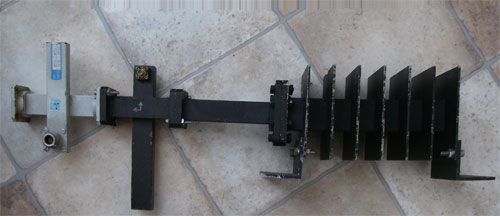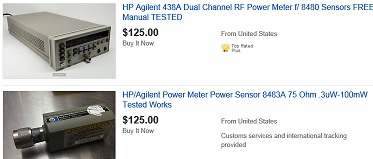To measure BUC power output:
e.g. BUC Power = 2 watts.
You make the measurement using a high loss crossed waveguide coupler and a power meter.

You read the loss value off the table on the side of the coupler (e.g -40.2 dB ). There are slightly different values according to frequency. The coupler on the left above is a nominal 40 dB loss coupler. Note it has an N type coax connector where you connect the power meter sensor.

Image shows an ebay sale of HP power meter and sensor.
Read the calibration factor using the table that comes printed on the sensor head for 50 MHz and calibrate using the 1 mW 50 MHz reference before use.
Connect the power meter sensor head to the N type socket on the waveguide,
having checked by calculation that you will not burn out the sensor head.Set the calibration factor on the meter using the table that is printed on the sensor head for the actual freq, say 14.2 GHz.
The meter may be set to display W, mW, uW or nW or dBm or dB(rel). Set dBm
BUC Power = meter reading + coupler loss.
Note that the power reading is the total RMS power, so if you are transmitting multiple carriers it is the addition of all of them.
All the above gives highly accurate results.
Warning 1: Power meters have expensive and sensitive sensor heads. Be careful not to burn them out. Make sure you know the maximum input rating and have a suitable high loss coupler or attenuator in front.
Warning 2: Always terminate the BUC output waveguide, either into the antenna feed system or an appropriately sized dummy load. Microwave power heats , and may burn, the human body. Never look down a waveguide as the power, and even quite low power, will cook your eye lens, which has no cooling blood supply.
Conversion:
Watts to dBW: 10 log (watts) dBW
Watts to dBm: 10 log (watts) + 30 dBm
dBW to dBm: dBW + 30 dBm
dBm to dBW: dBm - 30 dBW
dBW to watts: divide by 10, =, 10^x watts
dBm to milliwatts: divide by 10, =, 10^x milliwatts
Try to learn some or all of these:
+20 dBW = 100 watts
+10 dBW = 10 watts
+6 dBW = 4 watts
+3 dBW = 2 watts
0 dBW = 1 watt
-3 dBW = 0.5 watt
-10 dBW = 0.1 watt
0 dBW = +30 dBm
Best regards, Eric.




